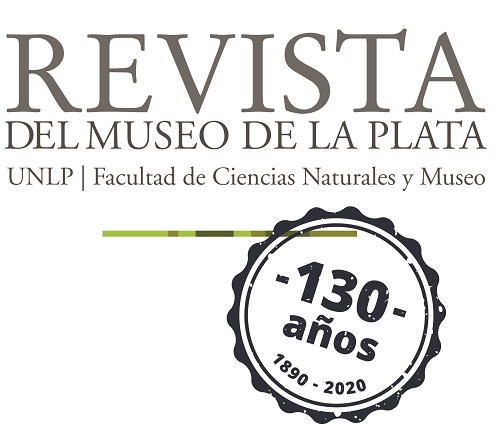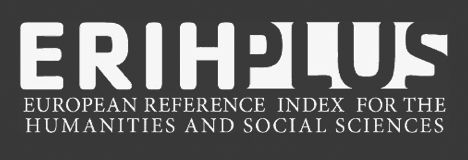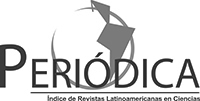Abundance of free-living marine nematodes with regards to physico-chemical characteristics of experimental and natural sediments
DOI:
https://doi.org/10.24215/25456377e124Keywords:
Experiment, Nematode, San Jorge Gulf, Pollution,Abstract
Nematodes have been widely used to evaluate different types of disturbances. The goal of this work was to compare the abundance of free-living marine nematodes communities at in situ and ex situ conditions, to assess the effect of experimental conditions in the laboratory. For this purpose, sediment samples were collected (n=4) at 3 sites in San Jorge Gulf (GSJ) with different history of pollution, and then incubated in the laboratory under controlled conditions of light, air and temperature for 45 days. At the end of this period, the ex situ treatment samples were analyzed, and an additional four samples were collected at the study sites (in situ). We compared the abundance of nematodes and characteristics of the sediment between both sets of samples. Restinga Alí and Playa Alsina showed increased abundance of nematodes (over 300 and 600%, respectively) in ex situ physico-chemical conditions compared to in situ conditions, while Punta Gravina showed lower abundance (less than 40%). Results showed an effect of the laboratory conditions set on nematode fauna. This effect was more evident in sediments from sites that had no previous history of pollution.References
Ansari, Z.A. & Ingole, B. (2002) ?Effect of an oil spill from M V Sea Transporter on intertidal meiofauna at Goa, India?, Marine Pollution Bulletin 44, pp. 396-402.
Armenteros, M., Pérez-García, J.A., Ruiz-Abierno, A., Díaz-Asencio, L., Helguera, Y., Vincx, M. & Decraemer, W. (2010) ?Effects of organic enrichment on nematode assemblages in a microcosm experiment?, Marine Environmental Research 70, pp. 374- 382.
Boufahja, F., Hedfi, A., Amorri, J., Aïssa, P., Beyrem, H. & Mahmoudi, E. (2011) ?An Assessment of the Impact of Chromium-Amended Sediment on a Marine Nematode Assemblage Using Microcosm Bioassays?, Biological Trace Element Research 142, pp. 242-255.
Burgess, R., Sharma, J., Carr, R.S. & Montagna, P. (2005) ?Assessment of storm water outfalls in Corpus Christi Bay, Texas, USA using meiofauna?, Meiofauna Marina 14, pp. 157-169.
Ditlevsen, H. (1911) ?Danish freliving nematodes?, Videnskabelige Meddelelserfra Danssknaturhistorik Forening 63, pp. 213-256.
Gambi, C., Lampadariou, N. & Danovaro, R. (2010) ?Latitudinal, longitudinal and bathymetric patterns of abundance, biomass of metazoan meiofauna: importance of the rare taxa and anomalies in the deep Mediterranean Sea?, Advances in Oceanography and Limnology 1, pp. 167-197.
Hägerbäumer, A., Höss, S., Heininger, P. & Traunspurger, W. (2015) ?Experimental studies with nematodes in ecotoxicology: an overview?, Journal of nematology 47, pp. 11-27.
Heip, C., Vincx, M. & Vranken, G. (1985) ?The Ecology of Marine Nematodes?, Oceanography and Marine Biology: Annual Review 23, pp. 399-489.
Jessen, G.L., Lichtschlag, A., Ramette, A., Pantoja, S., Rossel, P.E., Schubert, C.J., Struck, U. & Boetius, A. (2017) ?Hypoxia causes preservation of labile organic matter and changes seafloor microbial community composition (Black Sea)?, Science Advances 3(2), e1601897.
Kandratavicius, N., Pastor de Ward, C., Venturini, N., Giménez, L., Rodriguez, M. & Muniz, P. (2018) ?Response of estuarine free-living nematode assemblages to organic enrichment: an experimental approach?, Marine Ecology Progress Series 602, pp. 117-133.
Liu, X.S., Xu, W.Z., Cheung, S.G. & Shin, P.K.S. (2011) ?Marine meiobenthic and nematode community structure in Victoria Harbour, Hong Kong upon recovery from sewage pollution?, Marine Pollution Bulletin 63, pp. 318-325.
Losi, V., Ferrero, T.J., Moreno, M., Gaozza, L., Rovere, A., Firpo, M.,
Marques, J.C. & Albertelli, G. (2013) ?The use of nematodes in assessing ecological conditions in shallow waters surrounding a Mediterranean harbour facility?, Estuarine, Coastal and Shelf Science 130, pp 209-221.
Mahmoudi, E., Essid, N., Beyrem, H., Hedfi, A., Boufahja, F., Vitiello, P. & Aissa, P. (2005) ?Effects of hydrocarbon contamination on a free living marine nematode community: Results from microcosm experiments?, Marine Pollution Bulletin 50, pp. 1197-1204.
Maria, T.F., Vanaverbeke, J., Esteves, A.M., DE Troch, M. & Vanreusel, A. (2012) ?The importance of biological interactions for the vertical distribution of nematodes in a temperate ultra-dissipative sandy beach?, Estuarine, Coastal and Shelf Science 97, pp. 114-126.
Moreno, M., Albertelli, G. & Fabiano, M. (2009) ?Nematode response to metal, PAHs and organic enrichment in tourist marinas of the mediterranean sea?, Marine Pollution Bulletin 58, pp. 1192-1201.
Moreno, M., Ferrero, T.J., Gallizia, I., Vezzulli, L., Albertelli, G. & Fabiano, M. (2008) ?An assessment of the spatial heterogeneity of environmental disturbance within an enclosed harbour through the analysis of meiofauna and nematode assemblages?, Estuarine, Coastal and Shelf Science 77, pp. 565-576.
Netto, S.A., Gallucci, F. & Fonseca, G.F.C. (2005) ?Meiofauna communities of continental slope and deep-sea sites off SE Brazil?, Deep-Sea Research I 52, pp. 845-859.
Quang, N.X., Yen, N.T.M., Van Dong, N., Prozorova, L., Smol, N., Lins, L. & Vanreusel, A. (2018) ?Nematode communities in the Sai Gon River harbors in relation to tributyltin concentrations?, Marine Biodiversity 48, pp. 139-151.
Rosenberg, R., Hellman B. & Johansson B. (1991) ?Hypoxic tolerance of marine benthic fauna?, Marine Ecology Progress Series 79, pp. 127-131.
Schratzberger, M., Wall, C.M., Reynolds, W.J., Reed, J. & Waldock, M.J. (2002) ?Effects of paint-derived tributyltin on structure of estuarine nematode assemblages in experimental microcosms?, Journal of Experimental Marine Biology and Ecology 272, pp. 217-235.
Semprucci, F., Colantoni, P., Baldelli, G., Rocchi, M. & Balsamo, M. (2010) ?The distribution of meiofauna on back-reef sandy platforms in the Maldives (Indian Ocean)?, Marine Ecology 31, pp. 592-607.
Sperazza, M., Moore, J.N. & Hendrix, M.S. (2004) ?High-Resolution Particle Size Analysis of Naturally Occurring Very Fine-Grained Sediment Through Laser Diffractometry?, Journal of Sedimentary Research 74, pp. 736-743.
Vincx, M. & Heip, C. (1991) ?The use of meiobenthos in pollution monitoring studies: a review?, Benthic Communities: Use in Monitoring Point-source Discharges. ICES Techniques in Marine Environmental Science 16, pp. 50-67.
Downloads
Published
Issue
Section
License
La publicación en la RMLP se realiza bajo los términos de la licencia de uso y distribución Creative Commons BY-NC-SA 4.0 para Argentina (https://creativecommons.org/licenses/by-nc-sa/4.0/) que permite a terceros la distribución, la copia y la exhibición del artículo siempre que citen la autoría del trabajo, la publicación en la RMLP, número concreto y las páginas en la que encontraron la información. No se puede obtener ningún beneficio comercial y no se pueden realizar obras derivadas con fines comerciales que no autorice la editorial. Si se remezcla, transforma o construye sobre el material, deben distribuir sus contribuciones bajo la misma licencia que el original.
La puesta a disposición del artículo en la RMLP supone para los autores argentinos el cumplimiento de lo establecido en la Ley 26899 de Creación de Repositorios Digitales Institucionales de Acceso Abierto, Propios o Compartidos, del 13/11/2013 en su artículo 5º, en lo relativo a la obligatoriedad de facilitar en acceso abierto los resultados de investigaciones financiadas por agencias gubernamentales y de organismos nacionales de ciencia y tecnología del Sistema Nacional de Ciencia, Tecnología e Innovación.










